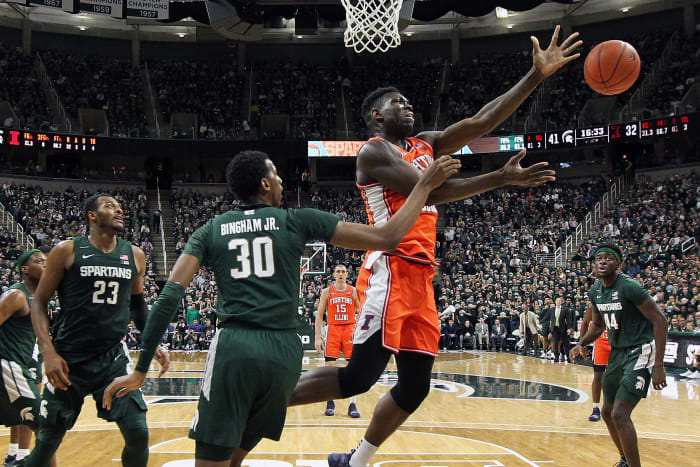‘Couldn’t make a shot’: Illinois Shooting Problems Now A Disturbing Trend
EAST LANSING, Michigan -- When it comes to the shooting woes of his basketball team, Brad Underwood knows two things and is confident of quite another.
What the Illinois third-year head coach knows is he can’t make shots for his perimeter guards and if they don’t start finding the bottom of the net more often, it doesn’t matter what set he calls out.
Following a frustrating 76-56 loss, Illinois (9-5, 1-2 in Big Ten) missed 25 of the 28 3-point shots they attempted and the first 15 they toss toward the basket. In terms of percentage, Thursday night’s escapade from beyond the 3-point arc wasn’t the worst (9.1 percent on 1 of 11 in a 71-62 win against Michigan on Dec. 11) but it was the most misses in a single game since the 73-71 overtime loss to Florida Atlantic on Dec. 29, 2018 when the Illini went 9 of 38 from 3-point range.
Underwood, who came to Champaign-Urbana with a .801 winning percentage as a head coach but is now 35-44 at Illinois, has repeatedly said he believes the shooting percentages would bounce back to at least the median level of what it was last season. Illinois shot 34.5 percent from 3-point range and returned a roster of eight of its top nine leading scorers from last season, returning a robust 85 percent of the points and 82 percent of the minutes.
“Couldn’t make a shot,” Underwood said. “I liked our shots. I liked where we were at. I liked our looks. You can’t do that on the road in terms of not make shots consistently. Tonight wasn’t our night. We’ll shoot the ball better next time we play.”
But can Underwood count on that optimism?
The following are players who have seen their 3-point shooting numbers statistically regress from last season:
- Ayo Dosunmu: 35 percent in 2018-19 season to 28 percent this season
- Trent Frazier: 40.6 percent in 2018-19 season to 35.3 percent this season
- Da’Monte Williams: 31.7 percent in 2018-19 season to 18.2 percent this season
- Andres Feliz: 27 percent in 2018-19 season to 25 percent this season
Illinois, which is 20 of 100 from 3-point range against power conference programs, is currently tied with Rutgers for 315th out of 353 Division 1 men’s basketball programs and the bottom of the Big Ten Conference in three-point shooting by converting just 29.5 percent. If that number stays put for the rest of the 2019-20 season, it would be the second-worst percentage in school history (1987-88 team shot 27.9 from 3-point range) since the three-point line was permanently installed in 1986. However, the Illini attempt the 11th most threes per game in the Big Ten.
And yet when asked if he thought the shooting was the reason behind the seventh loss of the Underwood era of 20 points or more, Dosunmu disagreed.
“That’s a fair assessment but I don’t feel that is the reason why we lost,” the sophomore guard said while declining to give an alternate theory citing “a closed locker room”.

Illinois center Kofi Cockburn (21) and Michigan State forward Marcus Bingham Jr. (30) fight for a loose ball during the second half of a game at the Breslin Center.
Mike Carter/USA TODAY Sports
Illinois has found offense and the bottom of the net on 54.6 percent of its two-point field goals thanks to the layups and dunks attained by freshman center and second-leading scorer Kofi Cockburn. The 7-foot, 290-pound force is shooting 55.7 percent on two-point field goals despite suffering a 2 of 10 outing at Michigan State Thursday night.
“He’s seen size before,” Underwood said. “We were sure trying to get it to him and trying to establish that. He’s been a big reason we’re one of the top offensive field goal percentage teams in the league. Again, he’ll learn to finish those.”
Michigan State sophomore Marcus Bingham, who had six blocks, said after the 20-point win that he believed his length bothered Cockburn near the rim. Junior forward Xavier Tillman said he used video scouting to make it difficult to near impossible for the high-low action of Giorgi Bezhanishvili to Cockburn to occur.
“I spent the last few days looking over (Bezhanishvili’s) tendencies on those passes and you could see some things he does before he makes those passes,” Tillman said.
Illinois currently converts on 54.6 percent of its two-point field goals and this statistic remains a major reason the Illini are fourth in the Big Ten Conference in field goal percentage and second in the league in points coming from the free-throw line.
Even in the current analytics era of the three-and-D basketball scheme that most teams from the high school, college and professional level run a version of, there is a simple solution to this problem identified by sophomore guard Alan Griffin in the post-game media scrum.
“Start going to the rim if our shot isn’t falling,” Griffin said. “As you know, we shoot good at home but when we’re on the road, we should get to the rim a lot more.”